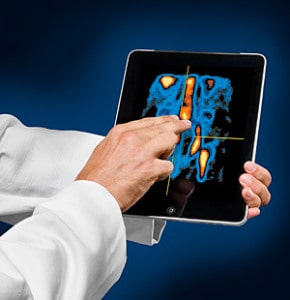
About NaviNet and Prematics
NaviNet’s focus has been on assisting providers (ambulatory practices) with administrative processes. NaviNet currently connects 70% of US physicians with payers through a multi-payer portal, providing online access to claims, PBM, and pharmacy data. The service is mostly free for physicians (they do pay for CMS access), with the payers footing the bill for everything else. In return, payers save on their own administrative costs, but also get another channel to pursue chronic care management messaging. These “healthcare alerts” and “care gap” messages are sent to the physician in an effort to coax care and patient behavior towards wellness and subsequently lower overall cost. More recently, NaviNet has begun looking to extend its reach and services offering, venturing from administrative process support to the clinical arena announcing in October the release of NaviNet EMR and NaviNet PM.
Prematics is known for mobile ePrescribing and is much smaller than NaviNet, with a physician base of only around 4,000. Prematics has had access to the exam room from ‘day one’ through its mobile ePrescribing platform built with lots of goodies on top (CDS, formulary support, medication history …). Prematics has leveraged this platform to move into the chronic care management space – similar toNaviNet – but with the important distinction that messages can be delivered to physicians while they are in the exam room delivering care. Prematics has Apps available on the iPhone, iPod Touch, iPad, and onWindows Mobile devices.
The Office Visit: Ripe for the Payer’s Taking?
Consider the typical, 7.5 minute office visit (in the exam room or a pre/post visit). These are precious minutes where a feeling of trust and general good-will between physician and patient should develop. After those 7.5 minutes are up, a physician should have been able to gather all the information she needed, and the patient should feel motivated to follow the doctor’s orders.
Authoritative symbols such as the white coat can help achieve this result, and so can the physician’s mobile device. Based on research for our report mHealth in the Enterprise, nearly 90% of all physicians carry a Smartphone and most of these make heavy use of clinical reference Apps. This is in direct contrast to EMR/EHR adoption, especially among very small practices who continue to be unmotivated by the HITECH Act.
Through the Smartphone or Touchscreen Tablet, the physician can have immediate access to vital patient information while the patient is right in front of them. Notably, this device does not interfere with the doctor-patient interaction as compared to a desktop. Patients do not experience the decrease in eye contact caused by their doctor seated in front of an immovable screen, and can even be intrigued with the cutting edge mobile technology in their doctor’s hand.
For the payer, the combination of trust and technology in the exam room represent an opportunity where real-time care messages can make an impact. When these messages are relayed through the trusted doctor, they might actually be listened to by the patient. With the Prematics acquisition, Navinet is making the bet is that the presence of the doctor delivering the message will drive patient engagement and behavioral change much more effectively than any nurse call center could.
Will providers welcome this intrusion into their space? True, the physician would like to be able to quickly answer such questions as: “Did he refill his prescription?”, or, “Is he comfortable paying the co-pay for the medication I am prescribing?”, but in order to get this information, is she willing to turn into a care-message proxy for the payer?
In any case, payers are open to try just about anything to contain costs, and the office visit still represents a yet unexplored setting.
Looking Forward
While Navinet+Prematics represents a powerful force which combines the market reach of Navinet plus the mobile expertise of Prematics, their biggest competitor remains the IT shops of payers themselves, who wish to build their own single-payer portals. Navinet still faces the upward climb of signing up these payers one by one.
This acquisition could also spur interest in other M&A activities for mobile chronic care management companies. Notably, WellDoc has been in the news lately for integrating its mobile chronic disease management solution with Allscripts as well as a recent strategic alliance with AT&T.
With the chronic disease epidemic now gripping the US, it is no surprise that so much attention is being paid to technologies that could potentially enact behavior change among physicians and patients and contain costs. While the NaviNet Prematics acquisition is a reflection of the optimism surrounding mobile technology as a solution, I remain skeptical that physicians will dutifully act on these messages, and even if they do, if patients will turnaround their behavior on the basis of an office visit.




Thanks, Cora. I noticed the text mentioning payers wishing to build their own portal is linked… to this very article. Do you have some research in this area?
Hi Ron, looks like that link is broken. See the link below for a (long) NaviNet interview that describes payers wishing to build their own single-payer portals:
http://www.sramanamitra.com/2009/12/30/building-a-national-health-information-network-navinet-founders-brad-waugh-and-tom-morrison-part-1/